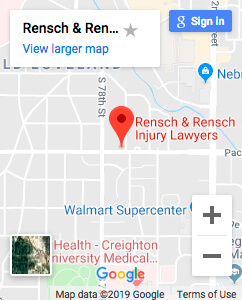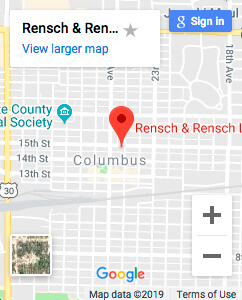Senior partner of Rensch & Rensch Law is Richard Rensch. His family and friends call him by his nickname, Dick. He is an avid motorcyclist. Throughout the spring summer and fall of the year Dick rides his Harley to work nearly every day – except of course when he is in court. His daily roundtrip combines over 15 miles of Omaha Nebraska’s heaviest high-speed city traffic with the city’s mixed urban neighborhood commuter traffic. His younger brother, Jeff, a less experienced rider, owns a BMW motorcycle. Jeff rides with Dick on occasion and therefore is the object of brotherly advice intended to improve Jeff’s well-being, riding experience and, of course, life expectancy. The following highlight the most important insights Dick has learned about safe riding techniques that you (as a novice or old pro) might not have read in any book or riding safety manual:
- Lane position: Visibility and precaution for your safety are the key considerations. When driving on any road or city street with just two lanes of travel (one for each opposing direction) stay away from the center line. Give yourself time to move out of the way – to the right for traffic crossing the center line. For similar streets in residential districts with feeder streets filled with motor vehicles waiting at the intersections to cross or turn onto your street, get close to the center (when no oncoming traffic is approaching) to make yourself more visible to those motor vehicles. When traveling on four lane streets (two lanes for each opposing direction) through town – with no medians – follow generally the same rules. Try to stay out of the inside lane but for visibility sake, position yourself on the far-left border of the far right or outside lane of travel. And turn your lights on!
- 3 Second Rule Minimum: This is mandatory if you want to live out your own life expectancy. Not 1 or 2 seconds. Feel free to extend to 4 or 5 seconds. What this means is that you must travel (at any speed) at least 3 seconds behind the moving vehicle in front of you. How to determine the proper distance is simple. Watch the vehicle in front of you pass a landmark that you will be forced to pass as you follow. As the landmark is passed by the vehicle ahead, start counting 1001, 1002 and 1003. Slow down until you can count three seconds off before reaching any chosen landmark. It is a scientific certainty that it takes the human brain ¾ of a second to perceive a danger and another ¾ of a second to act upon such danger. At 60 miles per hour you will have traveled 133 feet after a potentially fatal situation presents itself ahead of you – before you even begin to apply your brakes. That is nearly ½ the length of a football field! By keeping the 3 second rule you will give yourself a chance to recognize and react to most emergency situations.
- Eyes forward: It is the object ahead of you that kills you. Focus your awareness out ahead of you. Constantly sweep your forward danger horizon. Your danger horizon is the imaginary horizontal arch extending out ahead as far as you can reasonable discern distant but approaching objects, traffic patterns and road configurations that pose any potential for harm. You cannot allow anything to block your view of the danger horizon for more than a few seconds at a stretch. Strategically maintain a position within your lane that allows for your best view of your danger horizon. Continuous monitoring for and early detection of dangerous road debris such as truck tire shreds (called gators) or potholes will save your life – over and over again. You want to stay way ahead of the information available to you in order to diffuse any potential harm and prevent emergencies from happening altogether.
- Cover both your front and rear brakes in traffic: In city driving when going through intersections and in mid to heavy traffic, keep two fingers over the right front brake lever and the ball of your right foot touching the rear brake pad. That will cut down on the read and react time in case an emergency arises. Believe it or not, your front brake is more important to you for a quicker stop. 60-80% of the brake power shifts to the front (because of the combined forward weight shift of the rider and bike) in a slowdown. You need to practice braking in non-traffic situations. Practice on lonely stretches of roads or in empty parking lots. You must always expect a dangerous emergency. Never rely on the good driving abilities of anyone on the roadways – but yourself.
- These pointers are intended to add to the arsenal of defensive motorcycle riding strategies we all have acquired over the years. Following these and other time-tested biker rules of the road, should dramatically enhance your riding pleasure and well-being and those who share the highway with you.


